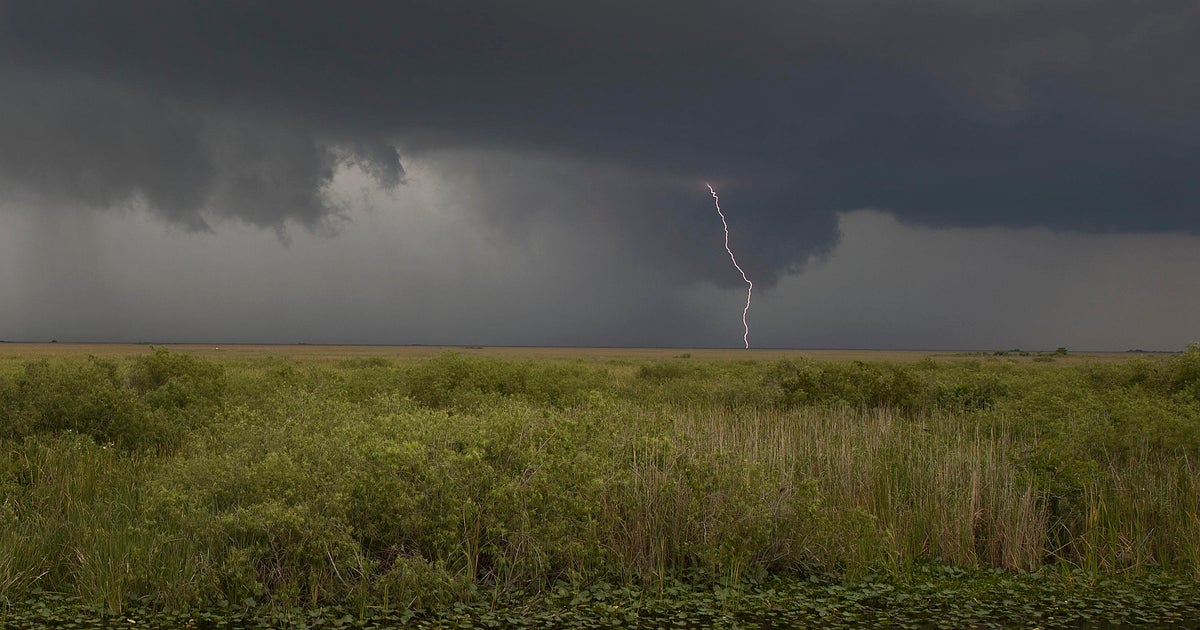Great White Shark 'Sable' Pinged Off Coast Of Northern Florida Keys
FORT LAUDERDALE (CBSMiami/AP) - For over a century, South Florida has drawn an ever-growing population of winter visitors escaping the frigid North. But birds, fish, and even sharks have also come to the southern part of the Sunshine State to escape freezing wintertime temperatures.
The latest arrival is a great white shark named Sable.
At 11:05 p.m on January 29, Sable sent up a "ping" from a satellite tag affixed to her dorsal tale from the Carysfort Reef in the Florida Keys. It meant the dorsal broke the surface of the water.
On January 23, she sent up a "ping" about 20 miles off the coast of Vero Beach.
Beachgoers have nothing to worry about — well, probably not. Sable may be 11.5 feet long, weigh over 800 pounds and have a mouthful of hundreds of razor sharp teeth, but she is nowhere near a beach. She was traveling along the edge of the Continental Shelf, where water depths are over 300 feet. She has traveled over 2,500 miles since being tagged.
So what do we know about Sable? Well, she likes long swims.
When the team from OCEARCH first met Sable, it was in the cool autumn waters off the coast of Nova Scotia on September 13th, 2021. Sable took a bait, and before she knew what was going on, she found herself being lifted up from below by a hydraulic lift on the OCEARCH research vessel.
The research team took length and weight measurements, blood samples and checked other vital signs. In 15 short minutes, the team can collect 12 different biological samples from the shark. The team then affixed a smart position or temperature (SPOT) tag on the dorsal fin and lowered the shark elevator (platform) back into the water.
"Sable is the 76th shark sampled, tagged and released in the nonprofit research organization's Northwest Atlantic White Shark Study and the third of Expedition Nova Scotia 2021," according to OCEARCH's website. "She was named after the Sable Island National Park Reserve, located approximately 180 miles offshore of Halifax, Nova Scotia, near where she was tagged."
Great white shark sightings in the waters along eastern Florida have become increasingly common in recent years. Bob Hueter, OCEARCH chief scientist, of Sarasota, was on the mission when Sable was tagged.
"At her size, she's probably starting to approach sexual maturity, and if not, she will be in a few years or so. She spent a couple of months cruising around Canadian waters feeding on high energy food like seals before she started coming south in the early part of the winter," said Hueter.
"If you follow her track you can see she pretty much made a steady progression down the coast, maybe lingered around Cape Hatteras a little bit," he added.
Hueter said when the white sharks come south, they can't feed on seals. But they may find whale carcasses, feed on other sharks or on certain kinds of fish. Possibly blackfin tuna, bonito, or other fish they can catch along the edges of the Gulf Stream.
"The region from Cape Hatteras to the Keys is part of their southern feeding range, but they tend to stay well offshore," he said. "The tagging research has taught us they are a common wintertime visitor to Florida waters."
Hueter said he hopes Sable sends more pings in the coming weeks and months.
"Keep an eye on Sable. I might predict she may continue down the coast and wrap around into the Gulf of Mexico. We should learn a lot because she has a 5-year tag on her."
(© Copyright 2022 CBS Broadcasting Inc. All Rights Reserved. The Associated Press contributed to this report.)



